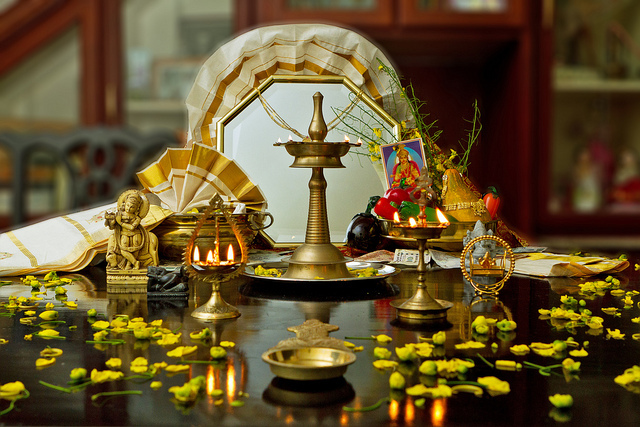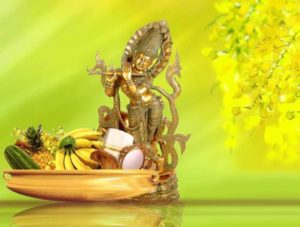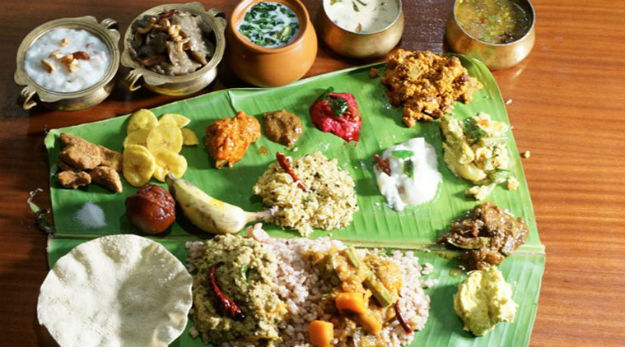Vishu : The New Year Of Malayalis (Kerala’s New Year) – God’s Own Country

What is Vishu ?
The word ‘Vishu’ in Sanskrit means ‘equal’. Therefore Vishu is more probably denoting one of the equinox days. Although Vishu (first of Medam) is the astronomical new year day of Kerala, the official Malayalam new year falls on the first month of Chingam (August-September).
Importance
This day is the astronomical new year day. Malayalis believe that the fortunes for the year depend upon the nature of the object one sees first in the morning of Vishu day. Malayalam month of Medam according to the Kollam calendar usually falls on April 14.
The Malayalam word Kani literally means “that which is seen first thing in the morning”. So, everything considered auspicious is laid out – an image of Vishnu, flowers, fruits and vegetables, new clothes (puthukodi) and gold coins.
Vishu Celebrations
As you all know, Kerala is named “God’s Own Country” because of its innumerable natural wonders. These natural wonders form the perfect backdrop to the state’s various festivals. Yellow flowers known as konnapoo (Cassia Fistula), which spreads across all the trees, forms part of this festival as well. Then comes the feast of Vishu, known as “Sadya”. The feast comprises equal proportions of salty, sweet, sour and bitter items. like mampazhappulissery and vishu kanji.
Vishu is also celebrated with fireworks, like Deepavali in the rest of the country. Lighting of lamps and bursting of firecrackers – known as vishupadakkam, form part of the celebrations.
As It Happens !
A reasonably sized Uruli is used to arrange the Kani. The uruli is made of panchaloham, an aggregate of five metals. Panchaloham being symbolic of the universe, which comprises the five great elements—earth, water, fire, air and space.
Searching for a Uruli? Get Here Now!
In the region of Kollam, Akshatam, a mixture of rice and turmeric, which is divided into halves of husked and un-husked rice, is placed in uruli. While in other parts of Kerala, Unakkalari (raw rice) is the first ingredient that goes into the Kani Uruli to act as a support base for the other items to be positioned.
This Vishu, Be Highly Nutritious, Order Raw Rice Today !
Placed over that is a fresh white cloth (with golden embroidery), followed by a carefully selected Kanivellari (golden coloured, shapely cucumber), Vettila (betel leaves), Pazhukkapakku (reddish yellow coloured ripe arecanut), golden coloured mango fruit, ripe yellow jack fruit (halved) and a shining brass valkannadi (hand mirror).
JACKFRUIT; Kerala’s Official State Fruit !!
A small flat-bottomed vessel, they keep little rice, a silver coin and some flowers.
Then the Kani Uruli is kept in front of the statue or picture of Lord Krishna (in Northern Kerala, the valkannadi signifies or is the embodiment of Goddess Bhagavathi). Then uruli, picture and the surroundings are decorated with Konnappoovu (Indian Laburnum). A lit Nilavilakku (bronze oil lamp) is placed nearby in such a way as it imparts a golden yellow hue to the Kani-ambience.
Spread Prosperity Everywhere, Buy Krishna Idol Here
Two lamps, which are fashioned from the two halves of a split coconut, are also kept in the uruli. The wicks are made from pieces of starched cloth that are folded into bulbs at the base. These bulbs are placed into the coconut oil that fills the lamps, anchoring the wicks in place. The lighting of the deepam welcomes God into our lives and is also symbolic of spiritual knowledge—the remover of the darkness of ignorance.
Gold, both in colour and in coin, is central to the Vishukkani. Kanikkonna, a golden-yellow flower is used liberally throughout the puja room. This flower only blooms when the sun is in its most exalted position astrologically, the month surrounding Vishu.
In the puja room, the flower verily represents the sun itself, the eyes of Lord Vishnu. Gold coins are symbols of monetary affluence, as well as cultural and spiritual wealth, which the elders of the family must share freely with the younger generation.
Vishu Kani
In the auspicious hour of the Brahma muhurata (4 am to 6 am), the elders in the house leads the other family members to the puja room with their eyes closed. Upon opening one’s eyes, one is overwhelmed with the glorious darshan of the Lord.
The mirror, which is symbolic of Bhagavati (Devi), not only increases the lustre of the Vishukkani via the reflection it offers, but also shows our own face. The mirror also points to the importance of making our mind pure enough to render devotional service with true and unadulterated love to Lord Krishna.
Note:- There are also beliefs that if you do not see a proper Vishukani, then you will lose a year from your life or have bad luck, depending on how much you see.
Next, comes the Kaineettam (token amount of money). The eldest member of the family takes some silver coins and gives them to all junior members with some raw rice and Kanippoo (flower of cassia). Vishukkaineettam should be given freely and accepted with reverence.
Vishu Feast
Vishu is also a day of feasting, wherein the edibles consist of roughly equal proportions of salty, sweet, sour and bitter items. Feast items include Veppampoorasam (a bitter preparation of neem) and Mampazhapachadi (a sour mango soup). Saddhya is a major part of all Kerala festivals. But for Vishu, Vishu Kanji and Thoran are more important. The Kanji is made of rice, coconut milk and spices. For the side dish, that is Thoran also there are mandatory ingredients.





















